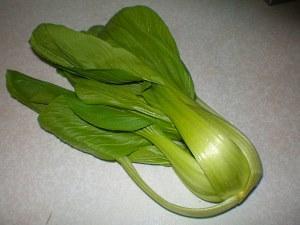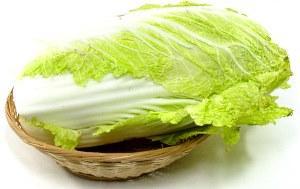Chinese cabbage - growing and care
 What is Chinese cabbage? Is this vegetable good for you? This article will answer these and other questions. From it you can learn about some of the intricacies of growing this vegetable crop. Good care tips will help you grow Chinese cabbage yourself.
What is Chinese cabbage? Is this vegetable good for you? This article will answer these and other questions. From it you can learn about some of the intricacies of growing this vegetable crop. Good care tips will help you grow Chinese cabbage yourself.
What does this vegetable represent?
Chinese cabbage is the oldest Chinese vegetable plant. He is loved in his homeland, but every year his demand is increasing in our country. Moreover, many amateur gardeners and summer residents successfully grow Chinese cabbage on their land plots. The main advantage of this vegetable is that the harvest of Chinese cabbage is obtained in absolutely any climate. That is, the cultivation of Chinese cabbage in Siberia is also possible.
Chinese cabbage is a head salad. This is what some gardeners call her. This vegetable is a representative of the cabbage species, but in terms of nutritional value it is much superior to its closest counterparts.
Chinese cabbage contains many useful substances, including in its composition:
- Vitamins of group B and PP.
- Vitamin C.
- The amino acid is lysine. The peculiarity of this substance is the ability to dissolve foreign proteins in the blood.

Types of Chinese cabbage
Chinese cabbage is a cold-resistant, moisture-demanding, early maturing vegetable. It can be of several types:
- Sheet.
- Semi-cabbage.
- Kochanny.
You should know that Chinese cabbage is divided into two closely related species, these are:
- Petsay. It is popularly known as Peking cabbage or lettuce.
- Pak choy or mustard cabbage.
 Quite often, these two species are combined under one common name - Chinese cabbage. But they differ not only in appearance, each subspecies has its own characteristics.
Quite often, these two species are combined under one common name - Chinese cabbage. But they differ not only in appearance, each subspecies has its own characteristics.
Peking has sessile and whole leaves. They have a swollen and wrinkled leaf plate with wavy and jagged edges. Their height is 15-35 cm. Peking cabbage leaves form a head of cabbage or rosette of different density and shape. The color of the vegetable is light green. The leaves of Chinese cabbage, on the other hand, are dark green in color. It never forms heads, but only a rosette of upright leaves, about 30 cm high. what is romanesco cabbage?
Chinese cabbage growing rules
 In order to get a good harvest of such a vegetable crop as Chinese cabbage, a photo of which is attached in this article, you need a well-cultivated soil and sufficient moisture. Digging up a future site in the fall, you can fertilize it with well-rotted manure at the rate of 4 kg per 1 sq. m. Peat for Chinese cabbage is strictly prohibited. With the onset of spring, the area dug up in the fall can only be loosened, since this type of cabbage loves compacted soils.
In order to get a good harvest of such a vegetable crop as Chinese cabbage, a photo of which is attached in this article, you need a well-cultivated soil and sufficient moisture. Digging up a future site in the fall, you can fertilize it with well-rotted manure at the rate of 4 kg per 1 sq. m. Peat for Chinese cabbage is strictly prohibited. With the onset of spring, the area dug up in the fall can only be loosened, since this type of cabbage loves compacted soils.
Chinese cabbage can get sick with keel. All types of this vegetable are exposed to this disease. Therefore, the soil for planting a plant should not be acidic.
In addition, it is undesirable to plant Chinese cabbage in places where crops such as previously grew:
- Turnip.
- Swede.
- Radish.
- Other types of cabbage.
It is important to know that Chinese cabbage is a short day plant. That is, with late spring sowing (from April to May) with the onset of hot days, this vegetable can bloom.
This is due to the fact that for the normal development of a head of cabbage, Chinese cabbage needs a certain air temperature - 15-22 degrees Celsius. It is also very important to remember about the maturation period of the head lettuce - 40-60 days.
Chinese cabbage is an early maturing vegetable. Therefore, spring planting should be done in open ground, taking into account the time it takes for the development and formation of a head of cabbage or a socket. This should be done before the onset of hot weather. These above-mentioned nuances are important not only when Chinese cabbage is grown in the Urals, but also for other regions.
If, nevertheless, a failure occurred during the spring sowing, and the plant released a peduncle, then there is no need to be upset. You can allow the Chinese cabbage to bloom and seed. The next year, the obtained seed material can be used to obtain a new crop.
For the use of a vegetable in autumn, Chinese cabbage seeds are sown in the second half of June. As practice shows, summer sowing gives higher yields. Seeds are sown in prepared soil according to the same principle as in April-May.
Well, now let's go directly to how to properly grow Chinese cabbage and what needs to be done for this. This vegetable is grown directly by sowing seeds in open ground or using pre-grown seedlings... Chinese cabbage is planted on seedlings in early April. Seeds are laid to a depth of up to 2 cm in separate containers with a diameter of no more than 3 cm. This cabbage is very difficult to transfer. For planting in open ground, the seedlings will be ready for 20 days.
The best distance between plants on a ridge is 40 cm, row spacing is 50 cm. It is not recommended to deepen the plants.
This cabbage is frost-resistant and can withstand a short-term drop in air temperature. Still, it is recommended to cover the planted plants with a special coating - for example, lutrasil. This will allow the seedlings to adapt more easily to new conditions and protect them from pests.
When sowing Chinese cabbage seeds in open ground, the distance between the rows is also about 50 cm. The seeds can be sown quite thickly. When the first shoots appear, it will be necessary to carry out thinning, combined with weeding. To begin with, you can leave a distance of 10 cm between the plants. Then, at the next weeding, thin out again, and so on until a distance of 40 cm is maintained between the cabbage. The torn seedlings can be eaten.
If the plant has taken root well, but its further growth has stopped, you need to pay attention to the presence of such pests as a cruciferous flea. This pest can completely destroy seedlings in a very short time.

Cruciferous flea beetles can be scared away using Chinese cabbage care tips, for this you need to:
- Powder cabbage leaves with ash after rain or watering. You can also use tobacco dust.
- Use special means - insecticides.
Chinese cabbage is quite demanding on hydration, so you need it periodically to water... But do not allow the soil to float.
It is advisable to combine watering with top dressing, which may be as follows:
- Weak solution of liquid organic matter.
- Fermented herb.
- Infusion of mullein or bird droppings.
As soon as the soil is watered, it needs to be slightly loosened, while it is not necessary to sprinkle the plant with earth. Hilling has an adverse effect on Chinese cabbage. Considering the above rules and some subtleties, you can get an excellent harvest of Chinese cabbage for both summer and autumn consumption.This type of cabbage is able to retain its beneficial substances after cutting and laying it for long-term storage.
I will share my experience of growing Chinese cabbage in Siberia. For several years I have been planting Chinese cabbage for early consumption as a salad crop. I even made cabbage rolls from it, it turned out great. But once it was necessary to arrange the remains of unrealized seedlings in a greenhouse around the perimeter. There was simply no place in the garden. Heads of cabbage for three weeks in the warmth, freely placed, grew large, almost a kilogram. But then it got hot and those that did not have time to go to the table bloomed. What did I write for? To get early greens, Chinese cabbage is more profitable than salads, and for sale it is ready before the rest of the greens, radishes. It is resistant to cold weather, the pests have not yet woken up. It is very profitable for entrepreneurs to grow fresh, beautiful greens in spring. The benefits of a head of cabbage from a garden are much greater than from a traveler from warm countries.